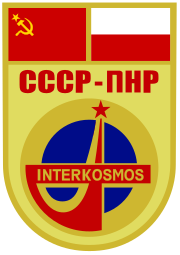The Soyuz 30 capsule, Hermaszewski's spacesuits and personal items, as well as memorabilia from the flight on display. | |
| Operator | Soviet space program |
|---|---|
| COSPAR ID | 1978-065A |
| SATCAT no. | 10968 |
| Mission duration | 7 days, 22 hours and 2 minutes |
| Orbits completed | 125 |
| Spacecraft properties | |
| Spacecraft type | Soyuz 7K-T/A9 |
| Manufacturer | NPO Energia |
| Launch mass | 6,800 kg (15,000 lb) |
| Crew | |
| Crew size | 2 |
| Members | Pyotr Klimuk Mirosław Hermaszewski |
| Callsign | Кавказ (Kavkaz - "Caucasus") |
| Start of mission | |
| Launch date | 27 June 1978, 15:27:21 UTC |
| Rocket | Soyuz-U |
| Launch site | Baikonur 1/5[1] |
| End of mission | |
| Landing date | 5 July 1978, 13:30:20 UTC |
| Landing site | 300 km (190 mi) W of Tselinograd |
| Orbital parameters | |
| Reference system | Geocentric |
| Regime | Low Earth |
| Perigee altitude | 197.6 km (122.8 mi) |
| Apogee altitude | 261.3 km (162.4 mi) |
| Inclination | 51.66 degrees |
| Period | 88.83 minutes |
| Docking with Salyut 6[2] | |
| Docking port | Aft |
| Docking date | 28 June 1978, 17:07:50 UTC |
| Undocking date | 5 July 1978, 10:15:40 UTC |
| Time docked | 6 days, 17 hours and 7 minutes |

| |
Soyuz 30 (Russian: Союз 30, Union 30) was a 1978 crewed Soviet space flight to the Salyut 6 space station. It was the sixth mission to and fifth successful docking at the orbiting facility.[2] The Soyuz 30 crew were the first to visit the long-duration Soyuz 29 resident crew.
Soyuz 30 carried Pyotr Klimuk and Mirosław Hermaszewski, the first (and to date, only) Polish cosmonaut, aloft.




